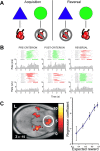What we know and do not know about the functions of the orbitofrontal cortex after 20 years of cross-species studies
- PMID: 17670960
- PMCID: PMC2630163
- DOI: 10.1523/JNEUROSCI.1556-07.2007
What we know and do not know about the functions of the orbitofrontal cortex after 20 years of cross-species studies
Abstract
When Pat Goldman-Rakic described the circuitry and function of primate prefrontal cortex in her influential 1987 monograph (Goldman-Rakic, 1987), she included only a few short paragraphs on the orbitofrontal cortex (OFC). That year, there were only nine papers published containing the term "orbitofrontal," an average of less than one paper per month. Twenty years later, this rate has increased to 32 papers per month. This explosive growth is partly attributable to the remarkable similarities that exist in structure and function across species. These similarities suggest that OFC function can be usefully modeled in nonhuman and even nonprimate species. Here, we review some of these similarities.
Figures

Similar articles
-
The functions of the orbitofrontal cortex.Brain Cogn. 2004 Jun;55(1):11-29. doi: 10.1016/S0278-2626(03)00277-X. Brain Cogn. 2004. PMID: 15134840 Review.
-
Integrating orbitofrontal cortex into prefrontal theory: common processing themes across species and subdivisions.Learn Mem. 2001 May-Jun;8(3):134-47. doi: 10.1101/lm.39901. Learn Mem. 2001. PMID: 11390633 Review.
-
Development of orbitofrontal function: current themes and future directions.Brain Cogn. 2004 Jun;55(1):1-10. doi: 10.1016/j.bandc.2004.01.001. Brain Cogn. 2004. PMID: 15134839 Review.
-
Decoding subjective decisions from orbitofrontal cortex.Nat Neurosci. 2016 Jul;19(7):973-80. doi: 10.1038/nn.4320. Epub 2016 Jun 6. Nat Neurosci. 2016. PMID: 27273768 Free PMC article.
-
Dopamine Modulates the Functional Organization of the Orbitofrontal Cortex.J Neurosci. 2017 Feb 8;37(6):1493-1504. doi: 10.1523/JNEUROSCI.2827-16.2016. Epub 2017 Jan 9. J Neurosci. 2017. PMID: 28069917 Free PMC article.
Cited by
-
The neural code of reward anticipation in human orbitofrontal cortex.Proc Natl Acad Sci U S A. 2010 Mar 30;107(13):6010-5. doi: 10.1073/pnas.0912838107. Epub 2010 Mar 15. Proc Natl Acad Sci U S A. 2010. PMID: 20231475 Free PMC article.
-
Morphologic and functional connectivity alterations of corticostriatal and default mode network in treatment-naïve patients with obsessive-compulsive disorder.PLoS One. 2013 Dec 16;8(12):e83931. doi: 10.1371/journal.pone.0083931. eCollection 2013. PLoS One. 2013. PMID: 24358320 Free PMC article.
-
Medial-lateral organization of the orbitofrontal cortex.J Cogn Neurosci. 2014 Jul;26(7):1347-62. doi: 10.1162/jocn_a_00573. Epub 2014 Jan 9. J Cogn Neurosci. 2014. PMID: 24405106 Free PMC article.
-
Gray Matter Changes in the Orbitofrontal-Paralimbic Cortex in Male Youths With Non-comorbid Conduct Disorder.Front Psychol. 2020 May 6;11:843. doi: 10.3389/fpsyg.2020.00843. eCollection 2020. Front Psychol. 2020. PMID: 32435221 Free PMC article.
-
Decision making: the neuroethological turn.Neuron. 2014 Jun 4;82(5):950-65. doi: 10.1016/j.neuron.2014.04.037. Neuron. 2014. PMID: 24908481 Free PMC article. Review.
References
-
- Bechara A, Damasio H, Tranel D, Damasio AR. Deciding advantageously before knowing the advantageous strategy. Science. 1997;275:1293–1294. - PubMed
-
- Bissonette GB, Martins G, Lande MD, Schoenbaum G, Powell EM. Assessing prefrontal cortical function in mice. Soc Neurosci Abstr. 2005;31:66–19.
-
- Butter CM. Perseveration and extinction in discrimination reversal tasks following selective frontal ablations in Macaca mulatta. Physiol Behav. 1969;4:163–171.
Publication types
MeSH terms
Grants and funding
LinkOut - more resources
Full Text Sources
